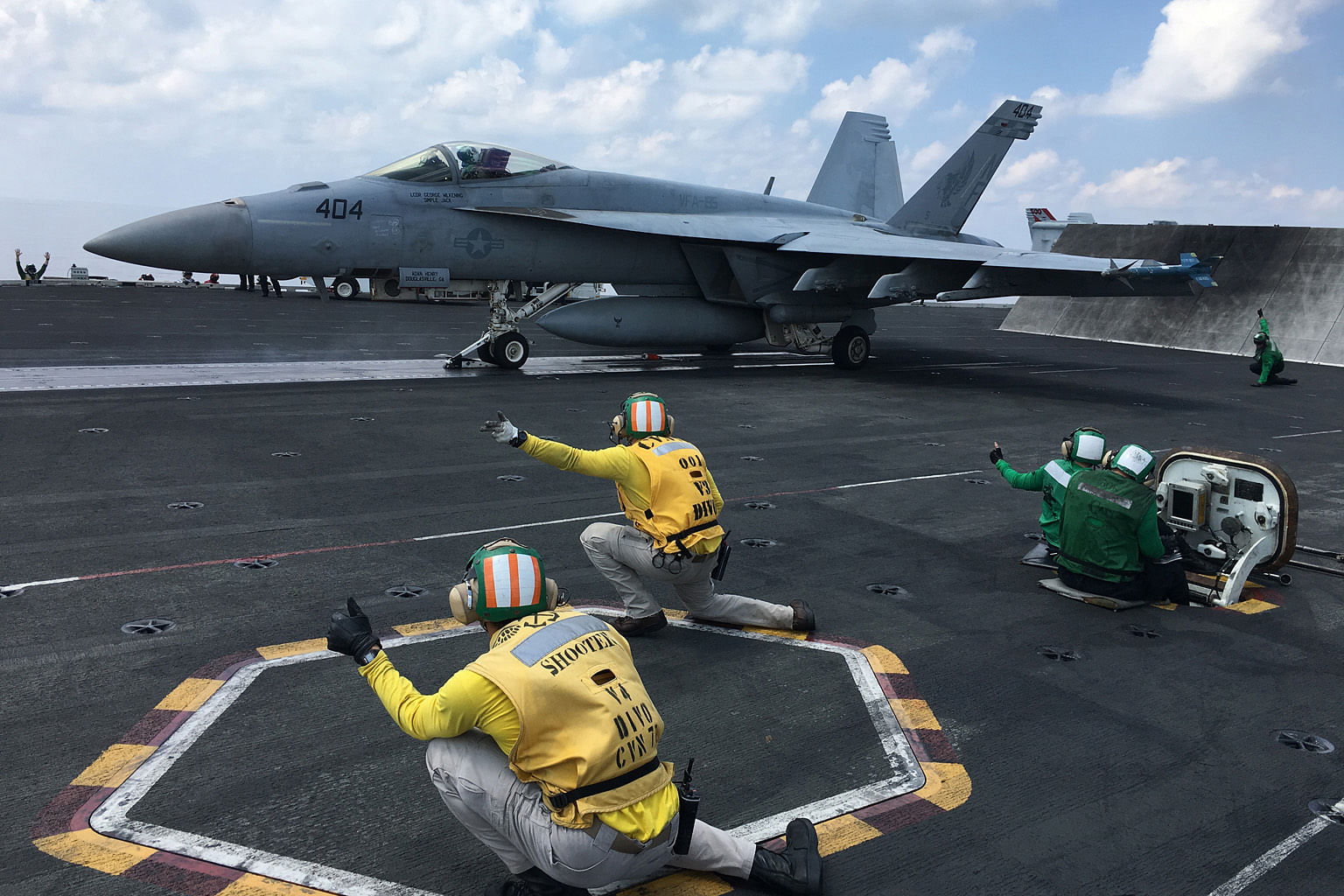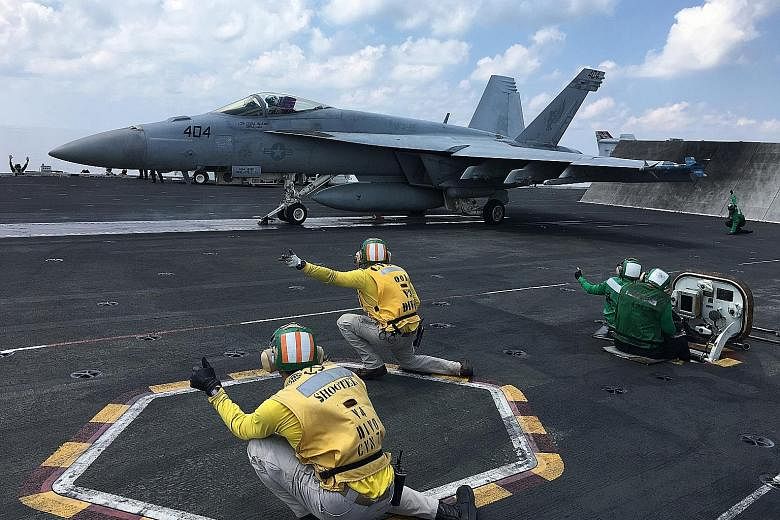The China strategy of US President Donald Trump's administration is confused and confusing, both in general and in particular vis-a-vis the South China Sea.
Ordinarily, US policy regarding some marginal sea in Asia would not be a front-burner issue. Indeed it should not be of prime importance when compared to US problems with North Korea and in the Middle East, and burgeoning front-line friction with Russia.
However, the South China Sea (SCS) has become a cockpit of contention and competition between the United States and China for military domination of the region and is now a frontier in troubled US-China relations. That is why the US needs urgently to formulate goals as well as a comprehensive strategy with objectives and tactics to reach them - and then articulate and implement that strategy.
What purports to be current US policy towards the SCS is a de facto continuance of the Obama administration's policy, punctuated by ad hoc decisions which fit Mr Trump's "let's make a deal" approach to foreign affairs. Indeed, some leaders in the region see the Trump administration's approach to the SCS issues as "case-by-case" and "spontaneous" rather than consistent, predictable and based on principle.
Indeed, after Mr Trump met China's President Xi Jinping on April 7 and 8 in Mar-a- Lago, it appeared that the US administration had backed off from criticism and actions against China in general, and over the South China Sea in particular - in return for China's assistance in stopping North Korea's nuclear weapon and missile development programmes.
As prominent Australian security analyst Hugh White points out, the fundamental question is: "What, if anything, is the US willing to do strategically to prevent China from controlling (the South China Sea)?"

Professor White clearly thinks there is no strategy or if there is one, it is not fully formed and not working. He argues: "If our aim is strategic, rather than legal (that is, if our aim is to use the SCS situation as an opportunity to push back against China's increasingly overt challenge to the US-led order in Asia), then we have to take actions which clearly demonstrate to everyone - in Beijing and elsewhere - that America (and its allies) are willing to risk a serious confrontation that would damage other areas of cooperation with China and could well escalate into a conflict in order to resist China's provocative actions."
He argues further that this is urgently needed "because China has been winning strategically in the SCS precisely because Washington has not been willing to take such risks hitherto. China has therefore been able to show that US resolve is weaker than China's, thus undermining US credibility and leadership, and (in a zero-sum game) bolstering China".
So what are these goals and what might a strategy and tactics to reach them look like?
GOALS AND TACTICS
US foreign-policy goals for the SCS are fairly easy to deduce. It wants to remain the dominant power and arbiter there - politically and militarily. It wants to prevent China from intimidating US friends and allies and thus weakening their "loyalty" to the US. It also wants China to comply with the Western-built and led "international rules-based order", including adherence to the Permanent Court of Arbitration arbitral tribunal decision against China's claims in the SCS. And it wants to maintain the current US-friendly regional security architecture. The US would probably add as a goal, protection of the "freedom of navigation" there, although this is an ambiguous and controversial concept.
Adding to the confusion, there was a pause of eight months between the last freedom of navigation operation in the SCS last October under the Obama administration and the first one under the Trump administration. That occurred late last month when the guided-missile destroyer USS Dewey made a non-innocent passage within 12 nautical miles of Mischief Reef. This manoeuvre indirectly challenged China's claim to sovereignty over the low-tide feature. China criticised it in part because it had stepped up its efforts to help the US with the North Korean problem - as requested by Mr Trump.
After last month's operation, US Secretary of Defence James Mattis said it was part of US strategy. Twice in February and once in March, the US Pacific Command formally requested Mr Mattis to authorise a freedom of navigation operation in the SCS. But he apparently turned down all three requests because he wanted such operations to be conducted in the context of a strategy which he had asked the command to formulate.
This has caused analysts to debate what that strategy is and where freedom of navigation operations fit into it. Some say the operations are a sign of US deterrence and resolve to uphold international norms, including the arbitration decision. Others say that is not so, and that they are or should be simply and solely a demonstration of a narrow legal point. This confusion was compounded by the appearance that all the relevant decision makers have become preoccupied with international political issues elsewhere - as well as domestic concerns.
This means that for China and the SCS, Pacific Commander Harry Harris has gained considerable influence regarding tactical decisions to implement "strategy" there. Admiral Harris is quite concerned about China's behaviour in the SCS and wants to take aggressive actions to deter it. So it seems we can expect more and more robust freedom of navigation operations, as well as continued intelligence, surveillance and reconnaissance probes - which China views as provocative. But these are tactics, not strategy.
At the Shangri-La Dialogue early this month in Singapore, Mr Mattis said his approach was a mix of support for and, if necessary, enforcement of "the rules-based international order"; encouraging a more inter-connected region regarding security matters; enhancing US military capabilities there; and reinforcing its defence relations with allies and willing partners, including training and weapons sales. This strategy is similar to former defence secretary Ashton Carter's stated approach to the region. But Mr Mattis added that the US "cannot and will not accept unilateral coercive changes to the status quo". However, this is a tactic, not strategy.
Also, his advocacy of adherence to the "rules-based order" has raised more questions than it answered. As Singapore's Defence Minister Ng Eng Hen put it after the dialogue: "Everyone agreed on a rules-based order but what the exact rules are, who benefits, whether it is accepted by more or less and how do you accommodate... regional interests, minority interests, were all questions raised." Unfortunately, these questions and others remain unanswered.
To answer these questions and bring clarity to the situation, the US needs to formulate and articulate its goals in the SCS and its strategy, objectives and tactics for achieving them. Professor Don Emmerson of Stanford University argues that as part of that strategy, the US has an opportunity to assure China "that it can, should and would play an appropriate stakeholder role in using and managing the uses of the SCS".
This would bring some clarity and thus enable China and each country in the region to make the decisions they need regarding their security and foreign policy towards China and the US.
•The writer is an adjunct senior scholar at the National Institute for South China Sea Studies, Haikou, China.

